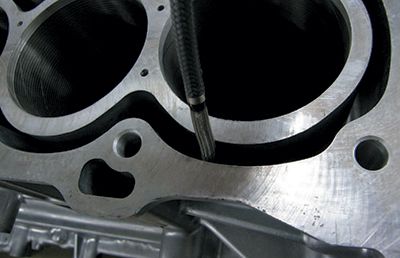Automotive inspections are challenging due to the large, complex structure of cars and the location of critical components – deep inside the engine, for example. Videoscopes are well suited for inspections in automotive manufacturing, QC and R&D. They avoid the need for disassembly by providing clear images of hard-to-access locations for easy detection of faults.
In the automotive industry, the value of cars is largely determined by the quality of individual components. Each component has its own potential faults and imperfections. Inspection technologies need to be versatile in order to detect faults with various lighting conditions and through different-sized access points. Dismantling or destructively testing specific components and parts costs both time and money. Remote visual inspection (RVI) extends the reach of the human eye into areas otherwise inaccessible, enabling inspectors to see defects clearly – even in hard-to-access locations within a car or its engine. The latest generation of RVI equipment, such as the Olympus IPLEX GX/GT videoscope, consist of a small diameter camera that an inspector can manoeuvre through narrow openings to capture images without requiring disassembly. This approach saves time, while ensuring the reliability of inspections through high quality images. |  Figure 1: Engine block water jacket inspection is a common application for industrial videoscopes. |
Application Example: R&D Durability Inspection of Test Engines at a Major OEM
Reducing Downtime
When choosing a videoscope for automotive OEMs and other manufacturing industries, it is important to select a device that is suitable for the broadest range of inspections and maintain the highest possible uptime. These aspects have a large impact, both on reliability and on return-on-investment.
Exchangeable scope units contribute to both uptime and versatility. The IPLEX GX/GT videoscope features exchangeable, durable scopes with a tungsten outer layer in lengths from 2 m up to 10 m and diameters including 4 mm and 6 mm. This variety allows one modular system to perform a multitude of tasks and essentially reduces both the initial capital expenditure and the total cost of ownership.
Since scopes in high-use applications need regular maintenance, the availability of more than one scope also means that inspections can continue while one scope is undergoing maintenance.
Increased Probability of Detection
Probability of detection is another key parameter for determining the value of inspection equipment. Both the articulation of the scope tip and the quality of videos and images determine the likelihood of a fault being detected.
The IPLEX GX/GT videoscope features advanced TrueFeel articulation, which maintains angular specification, even after a number of 90 degree turns. This allows every surface of a component to be viewed clearly – even with a single entry point. Furthermore, the bright illumination, 60 FPS video recording and a wide field of view provides superior image quality, facilitating fast, well-informed decision making.
Intuitive, Comfortable Operation
For high-throughput inspections, such as quality control in automotive manufacturing, a videoscope’s ease of use not only contributes greatly to user comfort, but also to the speed of inspections. Intuitive operation, imaging and documentation can help to avoid delays in inspection, analysis and reporting. InHelp inspection assist software is included as standard in every IPLEX GX/GT videoscope to reduce inspection time, simplify image management and streamline report generation.
Summary
RVI is a commonly used, fast and reliable way to inspect car components in the greatest detail. Olympus’ IPLEX GX/GT videoscope is a valuable tool in the automotive industry because of its ability to reduce downtime, allow easy operation and provide superb quality images – thereby providing critical data in automotive R&D, manufacturing and QC inspections.


